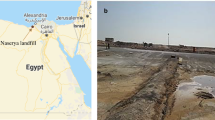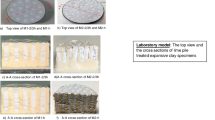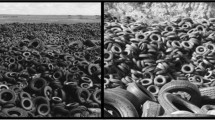Abstract
A large quantity of by-product lime wastes with high water content produced from chemicals manufacturing processes has been stacked in an open area in Incheon, Korea. Highly alkaline leachate and fine dust emanating from the stacked lime wastes caused an environmental concern in the city. So evaporative drying and stabilization of the fine-grained wastes and use of the on site marine clay as a natural geomembrane liner using drying hardening were considered as a part of a landfill construction plan. Treatment of the lime wastes and marine clay was focused on maximizing the evaporative drying and the density. Evaporation experiments were conducted in field condition to understand evaporation characteristics and to evaluate actual evaporation rate of the lime wastes and marine clay. Local Class A pan evaporation data from a nearby weather station for last 30 years indicated that mean annual and monthly evaporations were 1,178.5 and 98.2 mm, respectively. Relative evaporations of the sludge lime, cake lime, and marine clay compared with the pan evaporation were 114.9, 61.9, and 119.0%, respectively. Estimates of annual evaporations from storage surfaces in the field based on the relative evaporation data were 1,353.6, 729.1, and 1,402.2 mm for the sludge lime, cake lime, and the marine clay, respectively. And annual net evaporations considering rainfall effect were estimated as between 879.9 and 1,082.9 mm for the lime sludge, between 473.9 and 583.3 mm for the lime cake, and between 981.5 and 1,191.9 mm for the marine clay. It was expected that the actual field evaporation rate would be varied with the moisture contents of the lime and the clay. Results of these experiments will provide useful implications for the drying behavior of the by-product lime and the marine clay and landfill or management plan of the storages.








Similar content being viewed by others
References
Blight GE (2002) Measuring evaporation from soil surfaces for environmental and geotechnical purposes. Water SA 28:381–394
De Jesus ME (2001) Sludge management in Puerto Rico: present and future. MS Thesis, Department of Civil and Environmental Engineering, Massachusetts Institute of Technology
Fahey M, Fujiyasu Y (1994) The influence of evaporation on the consolidation behavior of gold tailings. In: Proceedings of 1st Int. Cong. Environ. Geotech., Bitech Publishers, Edmonton, pp 481–486
Fetter CW (1988) Applied hydrogeology. Merrill Publishing Company, Columbus
Fujiyasu Y, Fahey M (2000) Experimental study of evaporation from saline tailings. J Geotech Geoenviron Eng 126:18–27
Fujiyasu Y, Fahey M, Newson T (2000) Field investigation of evaporation from freshwater tailings. J Geotech Geoenviron Eng 126:556–567
Lee JY, Lee KK (2000) Use of hydrologic time series data for identification of recharge mechanism in a fractured bedrock aquifer system. J Hydrol 229:190–201
Lee JY, Kim YC, Yi MJ, Lee KK (2004) Hydrogeological investigation and discharge control of a nutrient-rich acidic solution from a coastal phosphogypsum stack at Yeocheon, Korea. Water Air Soil Pollut 151:143–164
Menziani M, Pugnaghi S, Santangelo R, Vincenzi S (1999) Field experiments to study evaporation from a saturated bare soil. Phys Chem Earth (B) 24:813–818
Menziani M, Pugnaghi S, Vincenzi S, De Leva M, Romano E (2003) Soil water content data for estimations of evaporation and infiltration in a suburban area. Geophys Res Abs 5:12749
Moon J-W, Song Y, Moon H-S, Lee GH (2000) Clay minerals from tidal flat sediments at Youngjong Island, Korea, as a potential indicator of sea-level change. Clay Miner 35:841–855
Newson TA, Fahey M (2001) Site investigation of saline gold storages in Western Australia. AusIMM Proc 306:1–13
Newson TA, Fahey M (2003) Measurement of evaporation from saline tailings storages. Eng Geol 70:217–233
Seneviratne N, Newson TA, Fahey M, Fujiyasu Y (1995) Some factors influencing the consolidation behaviour of mine tailings. In: Int. Sympo. Compre. Consolid. of Clayey Soils, IS–Hiroshima ‘95. Balkema, Rotterdam, pp 459–464
Seneviratne N, Fahey M, Newson TA, Fujiyasu Y (1996) Numerical modelling of consolidation and evaporation of slurried mine tailings. Int J Numer Anal Methods Geomech 20:647–671
Author information
Authors and Affiliations
Corresponding author
Rights and permissions
About this article
Cite this article
Lee, J.Y., Cheon, J.Y. & Hwang, D. Experimental study on moisture evaporation of lime wastes and marine clay: implications for landfill storage management. Environ Geol 50, 963–975 (2006). https://doi.org/10.1007/s00254-006-0265-6
Received:
Accepted:
Published:
Issue Date:
DOI: https://doi.org/10.1007/s00254-006-0265-6




